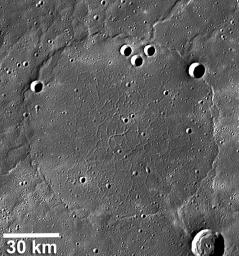
|
Ridge and Trough System on Mercury
- Click the image above for a larger view
- Full-Res JPEG (1430 x 1530) (368.0 kB)
- Full-Res TIFF (1430 x 1530) (2.2 MB)
Caption:
This image shows wrinkle ridges, which formed when the volcanic plains were pushed together and buckled, encircling a network of troughs or graben, which formed when the volcanic plains were stretched and pulled apart. The wrinkle-ridge ring, about 100 km in diameter, is formed over the rim of a ghost crater, an impact crater that was flooded and buried by lava flows. Read the full Mission News story for more details about a recently published scientific study of these unusual tectonic landforms
Instrument:
Mercury Dual Imaging System (MDIS)
Center Latitude:
60.2°
Center Longitude:
36.5° E
Scale:
See 30-kilometer (19-mile) scale bar on image
Background Info:
The MESSENGER spacecraft is the first ever to orbit the planet Mercury, and the spacecraft's seven scientific instruments and radio science investigation are unraveling the history and evolution of the Solar System's innermost planet. Visit the Why Mercury? section of this website to learn more about the key science questions that the MESSENGER mission is addressing. During the one-year primary mission, MDIS acquired 88,746 images and extensive other data sets. MESSENGER is now in a year-long extended mission, during which plans call for the acquisition of more than 80,000 additional images to support MESSENGER's science goals.
These images are from MESSENGER, a NASA Discovery mission to conduct the first orbital study of the innermost planet, Mercury. For information regarding the use of images, see the MESSENGER image use policy .
Cataloging Keywords:
| Name | Value | Additional Values |
|---|---|---|
| Target | Mercury | |
| System | ||
| Target Type | Planet | |
| Mission | MESSENGER | |
| Instrument Host | MESSENGER | |
| Host Type | Orbiter | |
| Instrument | Mercury Dual Imaging System (MDIS) | |
| Detector | ||
| Extra Keywords | Crater, Grayscale, Impact, Radio, Volcano | |
| Acquisition Date | ||
| Release Date | 2012-11-16 | |
| Date in Caption | ||
| Image Credit | NASA/Johns Hopkins University Applied Physics Laboratory/Carnegie Institution of Washington | |
| Source | photojournal.jpl.nasa.gov/catalog/PIA16540 | |
| Identifier | PIA16540 | |
